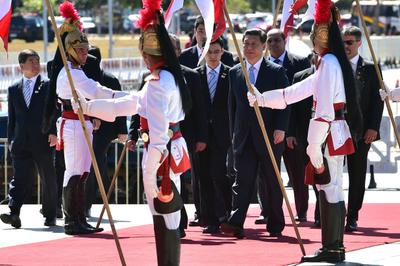Yet the leaders of Brazil, Russia, India, China and South Africa managed to agree on key features of the so-called ‘New Development Bank’ and the BRICS Contingency Reserve Agreement. Does this mean that critics were wrong to dismiss the BRICS as an ‘artificial bloc founded on a Goldman Sachs’ catchphrase’? Is this the first real step towards the long-awaited reshaping of the global financial architecture?
That an agreement was reached is impressive. But those who are pinning their hopes on a BRICS-led overhaul of global IFIs should not hold their breath. Fundamental issues persist and these will limit the BRICS’ ability to match ambitions with concrete action.
The New Development Bank will provide funding for infrastructure and sustainable projects in the founding members’ countries, as well as other emerging and developing economies. The initial authorised capital and subscribed capital is US$100 billion and US$50 billion, respectively. Brazil and India prevailed in ensuring that the subscribed capital will be divided equally among the five founders, thus limiting China’s power to assert greater influence over the bank.
Major points of contention on the bank’s leadership and location kept negotiations between India and China going until right before the launch. Finally, an agreement was reached that the headquarters will be located in Shanghai, while the first president will be from India. Brazil is to provide the bank’s first chair of the board of directors, and the first chair of the board of governors will be from Russia. South Africa will host the bank’s first regional centre.
The current set up of the BRICS Contingency Reserve Agreement is reminiscent of the Chiang Mai Initiative’s early form. It is a framework for financial support in response to actual or potential short-term balance of payment pressures. Total committed resources amount to US$100 billion with China contributing 41 per cent, South Africa five per cent, and the rest bringing in 18 per cent each. The BRICS Contingency Reserve Agreement does not constitute a common pool of funds; instead, funds will only be released for eligible requests. Most decisions regarding governance and operations will be done through consensus, yet approving requests for support will be decided by the majority based on weighted voting. Thirty per cent of the maximum access to funds is subject to approval by the members; the rest will remain tied to the IMF.
While the agreements are substantial, the hard part is yet to come. Scheduled to start lending in 2016, the New Development Bank has the potential to make an important contribution to addressing the global shortfall in infrastructure investment — estimated at around US$1–1.5 trillion per annum. But, if China’s influence is contained by keeping the share of subscribed capital equally distributed, this will drastically limit the bank’s lending capacity in the coming years.
While funding availability is one part of the problem, the availability of viable infrastructure projects is another. The BRICS would have to agree on criteria for project eligibility and cooperate on social, environmental and governance standards. If the founding members fail to reach an agreement, there is a plethora of existing and emerging development banks which focus on infrastructure investment. Latin America and Brazil both already have their own development banks. China has also started preliminary discussions on the Asian Infrastructure Investment Bank.
It is still not clear how (or whether) the BRICS New Development Bank will relate to these institutions. Regardless, the surfeit of alternatives suggests that there would be minimal pressure for the BRICS to cooperate on contentious issues.
There is no reason to believe that the BRICS New Development Bank and Contingency Reserve Arrangement will challenge the dominance of the World Bank and the IMF, or increase emerging powers’ influence in global financial architecture reform. The relative importance of World Bank lending in infrastructure may have recently declined but it is still the leading funder for poverty reduction. Despite rapid growth, both China and India still struggle with poverty reduction and are involved in lending programs with the World Bank.
It is already clear that the Contingency Reserve Arrangement will have substantial ties with the IMF. It is also likely to encounter the same challenges of surveillance and institutional capacity that ASEAN faces with the Chiang Mai Initiative Multilateralization and the ASEAN+3 Macroeconomic Research Office. With BRICS-led reform limited by these factors, progress in reshaping the global financial architecture ultimately hinges on the implementation of the IMF’s 2010 Governance and Quota Reform, on which the final push will come from the US Congress, not pressure from the BRICS.
The Fortaleza BRICS summit served a different purpose: it gave each member a platform to declare individual achievements not related to global financial governance — it was a platform for Modi’s first diplomatic success as prime minister and an opportunity for Putin to demonstrate that he still has allies despite growing tensions with Western powers. Reform of the global financial architecture is long overdue but it is unlikely that the BRICS countries will be its main drivers.
Maria Theresa Anna Robles is an Associate Research Fellow at the Centre for Multilateralism Studies (CMS) at the S. Rajaratnam School of International Studies, Nanyang Technological University.

